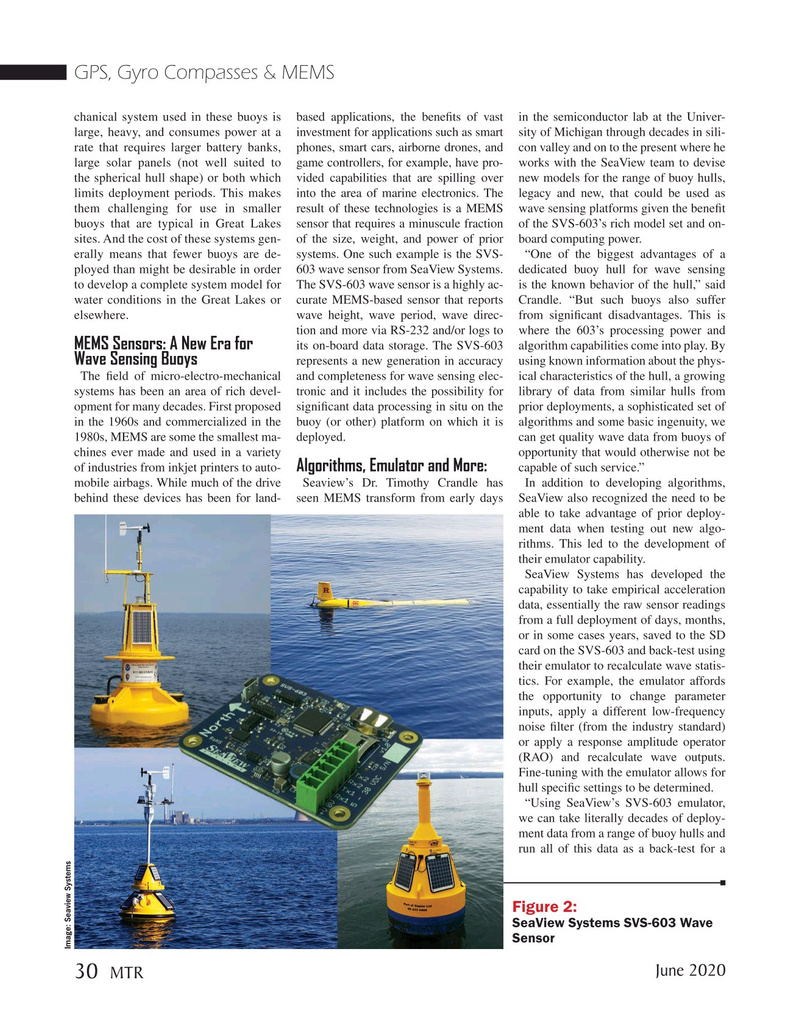
Page 30: of Marine Technology Magazine (June 2020)
Read this page in Pdf, Flash or Html5 edition of June 2020 Marine Technology Magazine
GPS, Gyro Compasses & MEMS chanical system used in these buoys is based applications, the benefts of vast in the semiconductor lab at the Univer- large, heavy, and consumes power at a investment for applications such as smart sity of Michigan through decades in sili- rate that requires larger battery banks, phones, smart cars, airborne drones, and con valley and on to the present where he large solar panels (not well suited to game controllers, for example, have pro- works with the SeaView team to devise the spherical hull shape) or both which vided capabilities that are spilling over new models for the range of buoy hulls, limits deployment periods. This makes into the area of marine electronics. The legacy and new, that could be used as them challenging for use in smaller result of these technologies is a MEMS wave sensing platforms given the beneft buoys that are typical in Great Lakes sensor that requires a minuscule fraction of the SVS-603’s rich model set and on- sites. And the cost of these systems gen- of the size, weight, and power of prior board computing power.
erally means that fewer buoys are de- systems. One such example is the SVS- “One of the biggest advantages of a ployed than might be desirable in order 603 wave sensor from SeaView Systems. dedicated buoy hull for wave sensing to develop a complete system model for The SVS-603 wave sensor is a highly ac- is the known behavior of the hull,” said water conditions in the Great Lakes or curate MEMS-based sensor that reports Crandle. “But such buoys also suffer elsewhere. wave height, wave period, wave direc- from signifcant disadvantages. This is tion and more via RS-232 and/or logs to where the 603’s processing power and its on-board data storage. The SVS-603 algorithm capabilities come into play. By
MEMS Sensors: A New Era for
Wave Sensing Buoys represents a new generation in accuracy using known information about the phys-
The feld of micro-electro-mechanical and completeness for wave sensing elec- ical characteristics of the hull, a growing systems has been an area of rich devel- tronic and it includes the possibility for library of data from similar hulls from opment for many decades. First proposed signifcant data processing in situ on the prior deployments, a sophisticated set of in the 1960s and commercialized in the buoy (or other) platform on which it is algorithms and some basic ingenuity, we 1980s, MEMS are some the smallest ma- deployed. can get quality wave data from buoys of chines ever made and used in a variety opportunity that would otherwise not be of industries from inkjet printers to auto- capable of such service.”Algorithms, Emulator and More: mobile airbags. While much of the drive Seaview’s Dr. Timothy Crandle has In addition to developing algorithms, behind these devices has been for land- seen MEMS transform from early days SeaView also recognized the need to be able to take advantage of prior deploy- ment data when testing out new algo- rithms. This led to the development of their emulator capability.
SeaView Systems has developed the capability to take empirical acceleration data, essentially the raw sensor readings from a full deployment of days, months, or in some cases years, saved to the SD card on the SVS-603 and back-test using their emulator to recalculate wave statis- tics. For example, the emulator affords the opportunity to change parameter inputs, apply a different low-frequency noise flter (from the industry standard) or apply a response amplitude operator (RAO) and recalculate wave outputs.
Fine-tuning with the emulator allows for hull specifc settings to be determined.
“Using SeaView’s SVS-603 emulator, we can take literally decades of deploy- ment data from a range of buoy hulls and run all of this data as a back-test for a
Figure 2:
SeaView Systems SVS-603 Wave
Sensor
Image: Seaview Systems June 2020 30
MTR

 29
29

 31
31
